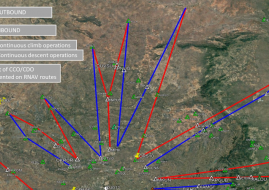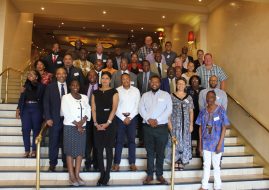Flying into the future – Managing chaos and complexity amidst a devastating Pandemic
We have now entered advanced alert level three of the national lockdown in South Africa. Infection statistics continue to rise – and so does the death rate.
Most organisations have reopened their doors – to their employees and customers. Things have changed, and everyone is expected to follow certain health-related protocols, in order to ensure the safety and wellbeing of their own as well as that of their colleagues. There is excitement, yet in some, fear and doubt reign supreme. As we go back to our familiar environment, albeit, in a different setting, everyone is hoping to normalise the unusual for such to be the “new normal”.
How do we see reality? For the past couple of years, I have been thinking and, in some instances, spoke about the need to come up with solutions that relate to difficult challenges. The prevailing pandemic situation is undeniably one such example. I was looking at ways to solving these problems, using methods that once worked (in such circumstances), yet considered to be inappropriate now. A question therefore arises – is this because we are comfortable with what we now know or is it perhaps something related to fear? Uncertainty maybe? The current crisis presents us with an opportunity – that of looking at other ways – to address challenges we are faced with.
Reality is that we work in organisations designed from “Newtonian images of the universe”, which is managing by separating “things” into parts. We believe that influence occurs as a direct result of force exerted from one “thing” to another. We engage in planning and making decisions for the environments and or scenarios that seem predictable, and we continue to search for methods that will objectively measure circumstances we find ourselves in. During a crisis, we tend to default to this particular way of doing things. We pull things apart hoping to make sense of or find something that will give us a clue on how to navigate our way forward. Processes, lists, charts, and procedures that we put forward do not capture this experience. The end result is our desire to control the reality that is slick, elusive, and a mystery to comprehend.
We are steadfastly held on the belief of “cause and effect” by looking at numbers to describe organisational health, productivity, and wellbeing – to name but a few. We develop graphs and charts that are meant to take us into the future. We organise work based on our beliefs, especially about the seemingly predictable universe. Our reality is based on the understanding that everything and anything we do, can be controlled. We also believe that the description of a modern way of a perfect and typical workday is putting structures in place through organisational designs, gathering numerical data, and making decisions based on some sophisticated mathematical formulas. In the end, we reduced, described, and separated things into cause and effect, and drew the world – our world – into lines and boxes.
The real world – the one that we live in – is characterized by unpredictability and uncertainty. Seeing the world in mechanistic images denies us the opportunity to see its dynamic and unpredictable nature. Instead of seeing cause and effect, we ought to understand the relationship between different variables. We need to see the world of what it is: a world of relationships, where things interact with one another in order to influence a certain outcome. Truth be told – the use of predictions and replications in a complex world are nearly impossible, if not non-existent.
The Covid-19 pandemic has prompted us to see the real world in a different way. In an organisational setting, this has taught us to embrace disorder and complexity. Organisations must think about the following: How do complex systems change? How structures are created (that are flexible and adaptive), that enable rather than constrain? Complexity – how things are simplified without losing that we value? How do we resolve personal needs, especially autonomy and growth, that commensurate with organizational need for prediction and accountability?
It is not a misnomer – the world has experienced many disasters and human tragedies in the past. To this end, authors Celliers (Complexity and postmodernism, 1998) and Dekker (Drift into failure: from hunting components to understanding complex systems, 2011) have summarised characteristics of a complex system that organisations must take cognisance of, and apply when trying to manoeuvre the intricacies of this pandemic, the Covid-19 pandemic:
- Complex systems have a history that must be considered when making decisions about the future. Organisations that choose to move forward during and after a disruption, must consider the pillar on which the organisation is built on. The process will not be complete if the dimension of time is not considered when making decisions, especially about the future of the organisation
- Complex systems are open to all the perturbations happening in the environment. Organisations are open systems. It simply means that they do not operate in a vacuum but are affected by the ever-changing environment. Whatever happens in the environment has an impact on their operations and it will be sensible to be aware and be prepared for such.
- Each element in a complex system is oblivious to the happenings and behaviour of the system as a whole. The complexity in the system comes from the interaction between different components, based on the information that each of them is presented with. When responding to the unexpected, organisations must consider every input from all levels (in the system)
- The interaction among different components is non-linear, and this means that small events can produce large results which is a precondition for complexity
- Components inside the system have a limited capacity to represent the complexity of the entire system. It is the interaction of these components at the local level that influences the complexity of the system. As such, a large number of components are necessary but not sufficient on their own.
- Complex systems operate under conditions far from equilibrium. Elements of the system must consistently make inputs towards the functioning of the system and ensure that the system operates optimally.
Flying into the future, managing and surviving the Covid-19 pandemic will require us to adjust and understand the complexity of our environment, search for solutions that are optimally comparative to given challenges, seize accessible opportunities and indubitably face constraints we are confronted with, and to take advantage of what we already know in order to move forward. Learning to look for wholeness is a skill that we need to harness. We need to lift our heads from the piece of paper where diagrams, charts, and graphs dance hypnotically before us – as we enter this world that is full of possibilities. And be able to do so without fear, anxiety, or prejudice.
Related Posts
« KZN Department of Transport engaged with senior management officials to examine a plan regarding Gender-Based Violence, Taxi Violence, All Truck Drivers Foundation (ATDF) and political killings within the province SARS Beitbridge Temporarily Closed Over A Positive COVID-19 Case »

































